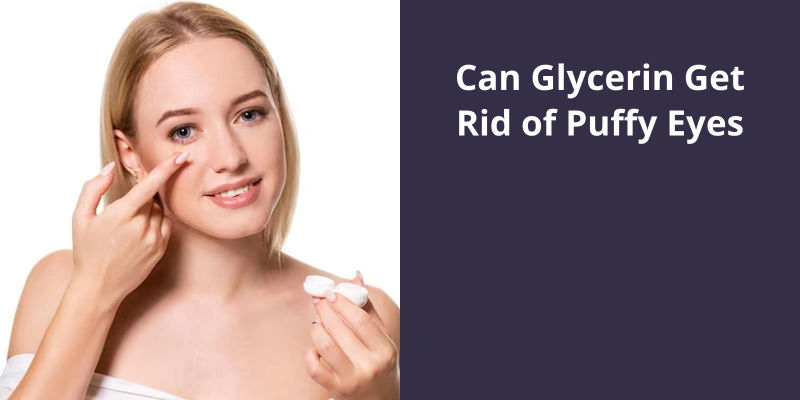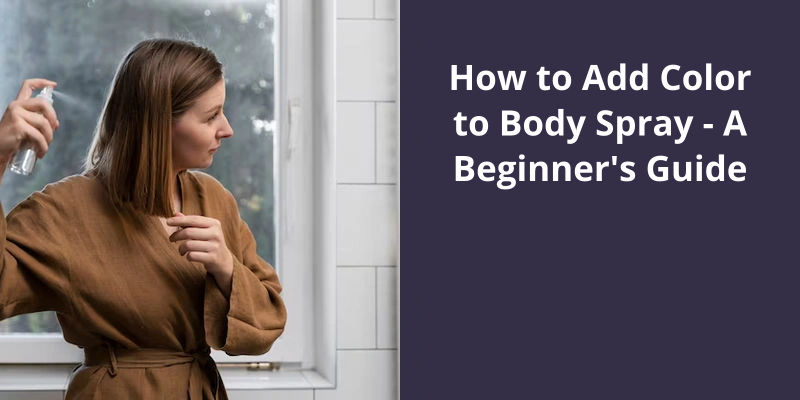Yes, Glycerin can help to get rid of puffy eyes. Glycerin has hydrating properties that can help reduce the swelling caused by water retention in the skin under your eyes, which is often the cause of puffiness. By absorbing water from the air and helping to retain skin moisture, it reduces skin swelling and helps in smoothing and softening the skin. However, it’s always important to use it carefully — it’s a powerful substance, so a little goes a long way. Also, avoid getting it into your eyes and always remember to do a patch test to ensure you’re not allergic. In some cases, you might want to seek advice from a dermatologist.

Is Glycerin Good for Under-Eye Wrinkles?
Glycerin, a popular ingredient in skincare products, is known for it’s moisturizing and hydrating properties. It’s been used for decades in various beauty routines and has proven to be effective in combating skin issues, including under-eye wrinkles. Glycerin acts as a humectant, drawing moisture from the atmosphere and locking it into the skin. This helps to plump up the skin, reducing the appearance of fine lines and wrinkles.
For all these reasons, glycerin is an excellent ingredient to include in any eye care routine. It’s a gentle and safe ingredient, suitable for all skin types.
We believe in harnessing the power of natural ingredients to provide our customers with the best possible skincare solutions.
Other Natural Ingredients That Are Effective in Treating Under-Eye Wrinkles
There are several other natural ingredients that are effective in treating under-eye wrinkles. One of these is cucumber. Cucumber has cooling and soothing properties, which helps to reduce puffiness and redness around the eyes. It also contains antioxidants that can help to tighten and firm the skin.
Another effective natural ingredient is green tea. Green tea is rich in antioxidants and contains caffeine, which can help to constrict blood vessels and reduce inflammation. This can help to minimize under-eye puffiness and dark circles.
Almond oil is another great option for treating under-eye wrinkles. It’s rich in vitamin E, which is known for it’s anti-aging properties. Almond oil can help to moisturize the delicate skin around the eyes, reducing the appearance of fine lines and wrinkles.
Vitamin C is also beneficial for treating under-eye wrinkles. It stimulates collagen production, which can help to improve skin elasticity and reduce the appearance of wrinkles. Look for eye creams or serums that contain vitamin C to target under-eye wrinkles.
Overall, while glycerin may help to hydrate the skin and reduce puffiness, there are many other natural ingredients that can also be effective in treating under-eye wrinkles. It’s always best to choose products that contain a combination of these ingredients to maximize their benefits.
Not only does glycerin serve as a moisturizer, it can also serve as a solution for brightening dark circles under the eyes. By targeting the delicate and thin layers of skin beneath the eye, glycerin has the ability to plump up this area, ultimately diminishing the appearance of dark circles. So, let’s uncover the potential benefits of applying glycerin to the under-eye area and explore whether it’s indeed a viable solution for dark circles.
Can We Apply Glycerine on Under Eyes?
Glycerin is a versatile and effective ingredient that can be applied to various skin concerns, including under-eye issues. When it comes to puffy eyes, glycerin can indeed be used to help reduce the puffiness. It’s hydrating properties can moisturize the skin around the eyes, helping to alleviate the appearance of puffiness.
Dark circles are often caused by thinning skin and lack of hydration in the under-eye area. Glycerin works by plumping up the thin layers of skin beneath the eyes, thereby reducing the appearance of dark circles. It’s moisturizing properties help to nourish and hydrate the delicate skin, allowing it to appear brighter and more even-toned.
Applying pure glycerin directly to the skin can be too concentrated and may cause discomfort. A gentle and effective way to use glycerin is by mixing a small amount with water or a facial oil, then gently patting it onto the under-eye area.
If you’ve sensitive skin or are prone to allergies, it’s always best to patch test any new product or ingredient before applying it to the delicate eye area. Additionally, maintaining a healthy lifestyle, including a balanced diet, sufficient sleep, and proper hydration, can also contribute to the overall health and appearance of the under-eye area.
The Benefits and Uses of Glycerin in Skincare
- Glycerin is a natural humectant, meaning it helps to attract and retain moisture in the skin.
- It can help to hydrate and soften dry, rough, or flaky skin.
- Glycerin has been found to have soothing and calming properties, making it beneficial for sensitive or irritated skin.
- It can help to improve the barrier function of the skin, reducing water loss and protecting against environmental damage.
- Glycerin is non-comedogenic, meaning it doesn’t clog pores, making it suitable for all skin types.
- It can act as an emollient, keeping the skin soft and supple.
- Glycerin has been found to have antimicrobial properties, helping to prevent and treat skin infections.
- It can also help to improve the appearance of fine lines and wrinkles, giving the skin a more youthful look.
- Glycerin can be used in various skincare products such as moisturizers, cleansers, serums, and masks.
- It’s also commonly used in the formulation of cosmetics and personal care products.
In addition to maintaining a healthy lifestyle, it’s important to address certain vitamin deficiencies that can contribute to puffy eyes. Among the culprits, Vitamin K and B12 deficiencies stand out as prominent causes. To combat these deficiencies, incorporating a variety of fruits and vegetables into your diet, along with an ample intake of water, will provide you with the necessary vitamins and minerals your body needs. Furthermore, reducing your salt intake can also help alleviate puffiness around the eyes. Now, let’s delve deeper into the different ways you can tackle these issues and regain a refreshed appearance.
Which Vitamin Deficiency Causes Puffy Eyes?
Deficiency of specific vitamins can indeed lead to the appearance of puffy eyes. Both Vitamin K and Vitamin B12 deficiencies have been known to contribute to this condition. Ensuring an adequate intake of these vitamins is essential in maintaining healthy eye tissues and preventing the occurrence of puffiness.
To combat these deficiencies, it’s important to incorporate a wide array of fruits and vegetables into your daily diet. These fresh produce items are excellent sources of various vitamins and minerals, including Vitamins K and BLeafy greens like spinach and kale are particularly rich in Vitamin K, while meats such as beef and fish are excellent sources of Vitamin B12.
Additionally, increasing your water intake is crucial for overall eye health. Hydration plays a vital role in reducing puffiness and keeping the skin around the eyes supple and elastic. Drinking plenty of water throughout the day helps flush out toxins and prevents the buildup of fluid around the eyes, diminishing the appearance of puffiness.
Furthermore, controlling salt consumption can effectively alleviate the puffiness around the eyes. High levels of salt in the diet can cause water retention, leading to bloating and puffiness. Reducing your sodium intake by minimizing processed and packaged foods, as well as avoiding excessive salt usage in cooking, can help combat these effects.
By addressing any potential deficiencies and implementing healthy dietary habits, you can significantly reduce the likelihood of experiencing puffy eyes. Remember to consult a healthcare professional for personalized recommendations and advice tailored to your specific needs.
Natural Remedies for Reducing Puffy Eyes: Provide Information on Natural Remedies, Such as Chamomile Tea Bags, Cucumber Slices, and Cold Compresses, That Can Help Reduce Puffiness and Soothe the Under-Eye Area.
- Chamomile tea bags: Soak two tea bags in hot water, then place them in the refrigerator to cool. Once chilled, place the tea bags over your closed eyes for 15 minutes. The anti-inflammatory properties of chamomile can help reduce puffiness.
- Cucumber slices: Slice a fresh cucumber and place the slices in the refrigerator for about 30 minutes. Place the chilled cucumber slices over your eyes for 10-15 minutes. The coolness of the cucumber and it’s natural astringent properties can help reduce swelling.
- Cold compresses: Take a clean washcloth and soak it in cold water or place it in the refrigerator for a few minutes to chill. Gently apply the cold compress to your closed eyes for 5-10 minutes. The cold temperature can constrict blood vessels and reduce puffiness.
Source: Get rid of puffy eyes! – The Times of India
In addition to implementing the nine practices mentioned earlier, there are specific ingredients that can be effective in reducing under-eye puffiness. Products infused with ingredients such as caffeine, green tea, niacinamide, peptides, and other anti-inflammatory components are known to be beneficial in depuffing the under-eye area.
What Ingredients Reduce Eye Puffiness?
Caffeine is a common ingredient in many eye creams and serums that target puffiness. It works by constricting blood vessels and reducing the appearance of swelling. Green tea extract is another effective ingredient, known for it’s anti-inflammatory properties. It helps to soothe the skin and reduce puffiness. Niacinamide, a form of vitamin B3, is also beneficial for depuffing under-eyes. It helps to improve the elasticity of the skin and reduce water retention.
Peptides are another powerful ingredient to look for. These small chains of amino acids help to stimulate collagen production, which can improve the firmness and elasticity of the skin around the eyes. Additionally, peptides have anti-inflammatory properties that can minimize puffiness.
Other anti-inflammatory ingredients, such as chamomile extract, cucumber extract, and aloe vera, are also worth considering. These natural ingredients have a calming effect on the skin and can reduce redness and swelling. Many skincare products also contain hyaluronic acid, which has the ability to hold moisture and hydrate the under-eye area, making it appear less puffy.
While these ingredients can be effective in reducing puffiness, it’s important to keep in mind that results may vary depending on the individual. It’s advisable to choose products that are specifically formulated for the delicate skin around the eyes and to follow a consistent skincare routine to maintain the desired results. Ultimately, finding the right combination of ingredients and practices that work for you may require some trial and error, but with patience and perseverance, you can achieve a more refreshed and depuffed appearance.
Overusing glycerin eye drops can potentially lead to worsened eye redness. Glycerin, along with naphazoline, is commonly found in eye drops used to treat redness, dryness, and burning. However, excessive use of these drops can cause a rebound effect, resulting in heightened redness. It’s important to follow the recommended dosage and consult a healthcare professional if symptoms persist or worsen.
Can You Overuse Glycerin Eye Drops?
While glycerin eye drops can provide relief for puffy eyes, it’s important to be cautious about overusing these drops. Glycerin works by drawing water into the eye, which can help reduce swelling and puffiness. However, using glycerin eye drops too frequently or for an extended period of time can have drawbacks.
Overusing glycerin eye drops may lead to a condition known as rebound hyperemia, where the blood vessels in the eyes become even more dilated and red. This can result in worsened eye redness and discomfort. It’s important to follow the recommended dosage and frequency guidelines provided by your healthcare professional or as stated on the product packaging.
It’s also worth noting that certain eye drops, such as those containing naphazoline, can cause similar issues if overused. Naphazoline is a vasoconstrictor that helps reduce redness in the eyes.
If your puffy eyes persist or worsen despite using these drops properly, it may be best to consult a healthcare professional for further evaluation and treatment options.
These include getting enough sleep, applying cold compresses to the eyes, avoiding excessive salt intake, and drinking plenty of water to stay hydrated. If you regularly experience puffy eyes, it may be beneficial to identify and address any underlying causes, such as allergies or sinus issues.
Following the recommended guidelines and seeking medical advice when needed can help ensure the best outcomes for your eye health.
Tips for Properly Using Glycerin Eye Drops
Glycerin eye drops can be effective in reducing puffy eyes and relieving dryness. Here are some tips for properly using glycerin eye drops:
1. Cleanse your hands before application to avoid contamination.
2. Tilt your head backward and pull down your lower eyelid to create a small pocket.
3. Squeeze one or two drops of the solution into the pocket without touching your eye.
4. Close your eyes gently to allow the drops to spread evenly.
5. Keep your eyes closed for a minute to maximize absorption.
6. Avoid blinking excessively or rubbing your eyes immediately after application.
7. Use glycerin eye drops as directed by your healthcare professional or the product instructions.
Remember to consult with a medical professional if you’ve any concerns or if the symptoms persist.
Conclusion
It’s unique properties as a humectant allow it to attract and retain moisture, effectively plumping the skin around the eyes and reducing swelling. By incorporating glycerin into your skincare routine, you may be able to enjoy the benefits of a more refreshed and revitalized eye area.




